Overview
The following information relates to Part 5 of the Cadastral Survey Rules 2021 (CSR 2021) and provides guidance on how parcels are to be dealt with including types of parcels and how parcels must be described.
Accounting for all land in an existing primary parcel
All primary parcels being extinguished must be replaced in their entirety by one or more new primary parcels, residue parcels, or balance parcels (r 39).
This requirement ensures that there are no gaps in the cadastre and that there are no portions of land where ownership is unknown or uncertain.
The extent of the new primary parcel boundaries must also be determined to a sufficient level of accuracy to ensure there is no risk of creating incompatible overlapping interests in land over neighbouring parcels (r 28).
Accounting for existing multi-polygon parcels
A multi-polygon parcel consists of two or more existing parcels that are linked together in Landonline and share an appellation and area.
Historically, multi-polygon parcels often resulted from Māori land partitions or where rural sections were severed into separate portions of land by the creation of a road or a Crown-owned water race. These separate parcels were sometimes depicted as linked together by a vinculum.
In dealing with multi-polygons where the appellation is being shared, actions will need to be completed within Landonline to enable the survey to be completed, as described below.
Existing multi-polygon parcels with separate areas
In the case of existing multi-polygon parcels, where each of the polygons has its own discrete area, only the polygon under survey needs to be subject to the normal definition and accuracy standards set out in the Rules. Other polygons are not required to be part of the survey.
If the separate polygons have been linked in Landonline, the surveyor will need to contact Toitū Te Whenua Land Information New Zealand (LINZ) through the exception process and request that the polygon under survey be unlinked from the other polygons in the spatial view of Landonline.
Create an exception request (New Landonline)
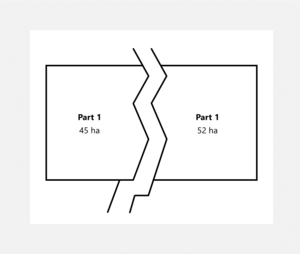
Figure 1 Multi-polygon parcel with separate areas for each polygon
Existing multi-polygon parcels without separate areas
In the case of multi-polygon parcels where the polygons do not have their own discrete areas, the survey must:
- address the subject polygon in the normal manner including definition and accuracy standards set out in the Rules
- in the survey report, provide a separate area for each other polygon that is not subject to the survey.
Because the polygons will have the same part appellation, the report must be unambiguous as to which area applies to which polygon.
Where the separate polygons have been linked in Landonline, the surveyor will need to contact LINZ through the exception process and request that the polygon under survey be unlinked from the other polygons in the spatial view of Landonline.
Create an exception request (New Landonline)
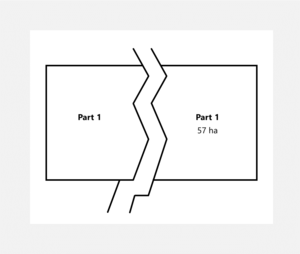
Figure 2: Multi-polygon parcel with a total area only
New multi-polygon parcels not permitted
New multi-polygon parcels are not permitted. A new parcel must be represented as a single polygon or polyhedron (Schedule 2 definition of parcel, r 83(b) and r 97(2)) unless it is an existing centre-line easement with unknown width or has been accepted under rule 54 (r 49).
Parcel Boundaries
The horizontal extent of both primary and non-primary parcels must be defined by boundaries with an approved form permitted by rules 38(1) and 46(1).
For primary parcels with a limited vertical extent, the vertical extents must be defined by height-limited boundaries (r 38(2)).
The vertical extent of a non-primary parcel, where the vertical extent is limited, must be defined by either a height-limited boundary or a permanent structure boundary (r 46(2)).
Refer to:
Minimum width of parcel
Rule 40(1)(a) requires a new primary parcel with class A boundaries to be at least 0.10 m wide. Similarly, new primary parcels with boundaries that are class B, C, or D must have a width of at least 0.20 m. This requirement is particularly relevant for new segregation strips.
Note rule 40(1) does not apply to an existing parcel already under-width, a balance or residue parcel (r 40(2)).
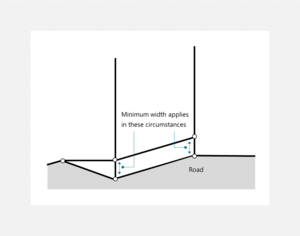
Figure 3: Examples of minimum parcel widths
Parcel area
The area of a primary parcel relates to the parcel's horizontal extent.
The area of a parcel must be correctly calculated from boundary information defining the boundaries (r 41(5)(a)) and be expressed in hectares (r 41(5)(b)).
Refer also:
Area for accretion
An area must be provided for portions of land claimed as accretion (r 41(3)).
The area of the updated primary parcel must include the area of accretion.
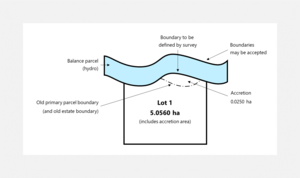
Figure 5: Areas for parcel that includes accretion
Area for erosion
Although the Rules require the depiction of land that has eroded (r 10(2)(a) and r 83(a)), they do not require an area for the erosion parcel, being a residue parcel (r 41(1)).
Area must not be shown for movable marginal strip
An area must not be shown for a movable marginal strip where the strip is depicted in a title diagram (r 97(3)(d)).
The area of the movable marginal strip is included in its associated primary parcel (r 41(1)).
Types of parcels
Primary parcels
As defined in Schedule 2, a primary parcel is any parcel that is or is intended to be:
- owned by the Crown, with the exception of a movable marginal strip
- held in fee simple
- Māori freehold land or Māori customary land
- part of the common marine and coastal area
- the bed of a lake or river
- road or railway
- vested in a local authority.
Balance parcels and residue parcels are primary parcels.
Refer to:
Non-primary parcels
A non-primary parcel is any parcel that is not a primary parcel (Schedule 2).
Non-primary parcels are often referred to as secondary or tertiary parcels. These are layers (formerly topology classes) used for non-primary parcels in Landonline. When the Rules are being applied, the term non-primary parcel should be used.
How to capture non-primary parcels (New Landonline Survey Support)
Height-limited parcels
Where a primary parcel is restricted in height it must be defined by a height-limited boundary (r 38(2)) and given a 'Height-Limited' prefix (r 43, Table 3).
When restricting the vertical extent of a primary parcel, a height-limited boundary must be a mathematically defined surface with at least one point having a reduced level, or the surface or bed of a water body (r 12).
All reduced levels are to be in terms of a single vertical datum and a vertical control mark must be included in the survey (r 18 and r 60).
Refer to:
Balance primary parcels
Historically, where a large existing parcel was subdivided into a new small parcel and a new large parcel, the term 'balance parcel' was used informally when referring to the new large parcel. This use is not correct in terms of the current Rules and should not be used in association with a CSD. The term ‘balance parcel’ now only applies to portions of railway, access way or service lane (not in a record of title), road, fixed marginal strip or waterbed that are intended to remain after a part has been removed by survey (refer to Schedule 2).
Balance parcels of road
Although a road appears to be a long undivided corridor of public land, it is divided up into separate polygons in the spatial view of Landonline.
When part of a road is to be stopped, the affected road polygon is divided into a road stopping parcel and a balance parcel (road), often referred to as a ‘balance road parcel’.
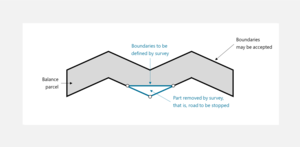
Figure 6: Balance parcel in case of road stopping
Balance hydro parcels
A balance parcel (hydro), often referred to as a ‘balance hydro parcel’, is created when an existing hydro parcel has a portion removed from it, for example when a portion of the parcel is being claimed for accretion or dry bed.
Note that the term hydro parcel is a term associated with Landonline and is not used in the Rules.
Refer to:
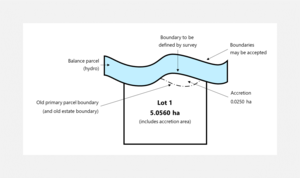
Figure 7: Example of accretion
Boundaries may be accepted for balance parcels
The existing boundaries of a balance parcel that are not common with another new parcel on the survey may be accepted (r 15(3)), in which case they are:
- not required to meet any accuracy standards (r 15(1)), and
- are class D (r 25), except for irregular, water and water centre-line boundaries which have no accuracy class (r 29).
Extinguished parcel
The term ‘extinguished parcel’ applies to a parcel that will disappear as a result of the survey and be replaced by one or more new parcels.
Note that although, historically, the term ‘extinguished parcel’ has been used to mean ‘the parcel being subdivided’, this term should now only be used as defined in Schedule 2.
Underlying parcel
The term ‘underlying parcel’ as defined in the Rules applies to a parcel that will remain intact as a result of the survey but whose interests are or will be directly affected or encumbered by a non-primary parcel. It is usually a primary parcel (new or existing) with a non-primary parcel such as an easement, covenant or unit parcel over it.
Note the term ‘underlying parcel’ is often used in a broader context to mean the parcel being subdivided or land under survey. If the term is used in a broader context to refer to the underlying land in general, then care needs to be taken that the meaning of the term is clear and not confused with the use of the term as defined in Schedule 2.
There are circumstances where an underlying parcel is not necessarily a primary parcel. Two examples are:
- Where an easement will be created over a lease parcel. In this case, the lease parcel (a non-primary parcel) is encumbered and is therefore the underlying parcel. The primary parcel on which the lease sits is not affected and therefore is not the underlying parcel.
- Where an easement will be created over common property, or over a unit, as part of a unit title development. In this example the common property or unit (a non-primary parcel) is encumbered and is therefore the underlying parcel. The primary parcel the unit development sits on is not affected and therefore is not the underlying parcel.
Donut Parcel
A donut parcel is a parcel that is completely surrounded by another parcel and share common boundaries. They are two independent parcel rings.
An example of this is where a farm park allotment is located in the middle of a larger shared use allotment. The inner allotment forms an inner parcel 'boundary ring' common with the inside boundary of the larger surrounding allotment.
Care needs to be taken when accounting for donut parcels or parcels that surround an existing donut parcel to avoid gaps or overlaps with adjacent parcels.
The layer and capture requirements for donut parcels can be complex.
Parcels with accretion or dry stream bed
Although the bed of a lake, river, stream, or the sea appears in the Landonline spatial view as an undivided hydro-parcel, it is often divided into separate polygons in that view.
Where accretion or dry steam bed is being claimed, the remainder of the hydro parcel not being claimed is a balance parcel (hydro). See Figure 7.
Erosion parcels
In the case of erosion, the extinguished primary parcel is divided into two new primary parcels; a ‘dry’ primary parcel and a ‘wet’ erosion parcel. The new parcel intent of ‘Erosion’ and not ‘Hydro’ must be used for the erosion parcel that defines the eroded area.

Figure 8: Erosion parcel
An erosion parcel is effectively a residue parcel that remains after an area of erosion is excluded from a primary parcel under survey. This preserves the status of the new water boundary formed by the erosion. See Figure 8 above.
An erosion parcel becomes associated with the adjoining water body it abuts. For example, the erosion primary parcel adjacent to the Turtle River becomes part of the bed of the Turtle River.
Residue parcels
Schedule 2 defines a residue parcel as the residual portion of a primary parcel:
(a) that remains as a result of a survey:
- for removal of limitations as to parcels, or
- for an adverse possession claim, or
- to change the registration of land from the Deeds Registration Act 1908 to the Land Transfer Act 2017, or
(b) that:
- is being defined as part of the bed of a lake, a river, or the common marine and coastal area, and
- is not currently recorded in the cadastre as the bed of a lake, a river, or part of the common marine and coastal area, and
- is not intended to vest, and
- is not intended to have a new estate record.
Residue parcels comprising common marine and coastal area
Tidal boundaries - Recording parcels of common marine and coastal area
Residue parcels comprising lakebed, streambed or riverbed excluded from title
Water boundaries - Recording water bed excluded from a new title
Boundaries of residue parcel may be accepted
The boundaries of a residue parcel that are not common with another new parcel on the survey may be accepted (r 15(3)), in which case they are:
- not required to meet any accuracy standards (r 15(1)),
- class D (r 25), except for irregular, water and water centre-line boundaries which have no accuracy class (r 29).
See Figure 10 below for an example.
Residue parcels comprising land ‘limited as to parcels’
Where the title is limited as to parcels and land is held in possession adverse to the registered proprietor, a residue parcel will be created.
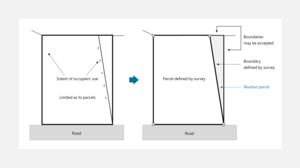
Figure 9: Residue parcel
Residue parcels resulting from adverse possession claim
Where a claim of adverse possession is being made for part of a parcel, the remaining portion of the parcel not being claimed must be a residue parcel.
Recording residue parcels
A survey diagram and title diagram must depict the extent of all residue parcels (r 83(a) and r 97(1)(a)).
A survey diagram and title diagram must also include the appellation of each residue parcel for which an appellation is required by rule 42 (r 83(c) and r 97(3)(b)).
In specified cases where the existing appellation must have the prefix 'Part' (r 42(2), it may be abbreviated providing it is unique. An example is 'Part Lot 5 DP 746' depicted in Figure 10 below as 'Pt 5'.
The boundary dimensions for accepted boundaries of a residue parcel which are not common with a new parcel are not required to be depicted (r 105(2)(b)).
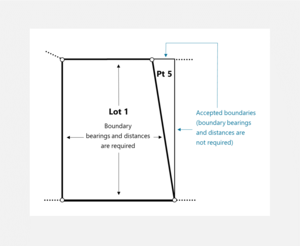
Figure 10: Accepted boundaries on a residue parcel
Primary parcels defining river or lake bed to vest
Where part of the bed of a river or lake is to vest under s 237A(1)(a) or s 239(1)(c) of the Resource Management Act 1991 (RMA) it must be depicted as a new primary parcel.
Water boundaries - Recording water bed to vest under sections 237A or 239(1)(c) RMA 1991
Primary parcels defining common marine and coastal area
Where land is to become part of the common marine and coastal area under s 237A(1)(b) of the RMA, it must be captured and depicted as a new primary parcel.
Land must be depicted as a residue parcel where it was held by the Crown or territorial authority and has already become part of the common marine and coastal area pursuant to the Marine and Coastal Area (Takutai Moana) Act 2011 (MACAA).
Non-primary parcels defining esplanade strips, movable marginal strips and fixed marginal strips
Marginal strips are strips of land abutting the coast, larger lakes and rivers greater than three metres in width. They are created under Part 4A of the Conservation Act 1987 and are deemed to be created on disposal of Crown Land.
A movable marginal strip is land owned by the Crown, a status that usually applies only to primary parcels.
Notwithstanding Crown ownership, a movable marginal strip parcel is to be treated as a non-primary parcel within the appropriate primary parcel. This distinction is made to give effect to Part 4A of the Conservation Act 1987 which does not require the strip to be excluded from the title to that primary parcel.
A fixed marginal strip is a similar strip that was reserved from sale or other disposition on any Crown land, prior to the Conservation Act 1987 or under that Act before the movable marginal strip provisions came into effect in April 1990. It is deemed to be reserved to the Crown as a marginal strip of the same width (s 24(3) of the Conservation Act 1987).
Esplanade strips are created along the mark of mean high water springs of the sea, the bank of a river, or the margin of a lake when land is subdivided or reclaimed, or at any time by agreement between a landowner and the local authority. The requirements are specified in Part 10 of the RMA. Esplanade strips created on a subdivision or reclamation are required to be shown on the resultant CSD (ss 237 and 245 of the RMA).
Water boundaries - Recording movable marginal strip and esplanade strip parcels
Walkway parcels
Walkways to be created under the Walking Access Act 2008 may be created by an easement or lease over land, in which case the parcel will be a non-primary parcel.
Alternatively, the land may be purchased, in which case the parcel would be a primary parcel (ss 26 and 29 of the Walking Access Act 2008).
Parcel appellation
Correctly identifying new parcels to be created and underlying parcels where new and existing interests are to be registered ensures the resulting registration of ownership and interests in the land are uniquely identified.
The format of a parcel appellation differs depending on the type and intent of the new parcel or interest being created.
The following information relates to Part 5 Subpart 3 and parcel appellations for general land and Māori land, with specific attention given to residue and balance parcels, non-primary parcels, unit parcels, and cross lease parcels.
Parcel appellation for general land
New primary parcels defining general land must be identified with an appellation that uses three components in the following order (r 42(1)).
| Appellation component and order | Example |
|---|---|
| 1. Parcel type | Lot |
| 2. Unique identifier | 1 |
| 3. CSD number | DP 405689 |
Parcel appellation for Māori freehold land
Māori freehold land must be described by the use of three components in the following sequence (r 44).
| Sequence | Example |
|---|---|
| 1. Block name | Tumu |
| 2. Unique parcel identifier | A7 |
| 3. CSD number | ML 417582 |
Except as permitted by rule 44(2) the unique parcel identifier must be a sequence of alternating letters and numbers (r 45, Table 4).
Māori appellation only for Māori freehold land
Only Māori freehold land is permitted to use the provisions of rule 44. Land with an existing Māori appellation that has a status of General land must be provided with a General land appellation.
Māori freehold land is defined in s 129 of the Te Ture Whenua Māori Act 1993 as ‘land, the beneficial ownership of which has been determined by the Māori Land Court by freehold order’. If there is any doubt as to whether land is Māori freehold land, the Māori Land Court (MLC) should be consulted.
Exception to appellation format for Māori Land
An exception to the standard appellation format is permitted where an alternative legal description has been notified by the MLC (r 44(2)). Note, however, that irrespective of the MLC legal description, the CSD number must be part of that appellation (r 44(1)(c) and r 44(2)).
Any MLC notification of an alternative legal description must be reported in the survey report (r 72(q)).
Appellation for legalisation surveys
A Legalisation CSD is a SO dataset. As such, apart from Māori land in some circumstances (see below), new primary parcels must be described in the form 'Section [number] SO [number]' or ‘Height-Limited Section [number] SO [number]’ where the parcel has a height-limited boundary (r 42 and r 43).
Māori freehold land to be acquired must be described as 'Section [number] SO [number]', for example Section 1 SO 456892. Alternatively, use ‘Height-Limited Section [number] SO [number]’ if the parcel has a height-limited boundary.
However, the remaining land that is not part of the legalisation action must be described in the form: ‘Block name, unique parcel identifier, SO number, for example Rotorua 2A1 SO 456892.
Alternatively, a legal description confirmed by the MLC may be used, but all parcels must have the plan number in their appellation.
Appellation for residue and balance parcels
Residue parcels and balance parcels that have an existing parcel identifier must retain their existing description and have the prefix 'Part' added to them (r 42(2)).
Where a balance parcel does not have an existing unique parcel identifier but has an existing description such as sea, road or railway, then this parcel retains that description.
Recording road, rail, and water body names and descriptions
A survey diagram and title diagram must depict the name of any road, railway, or water body where it abuts a new parcel. Examples are 'Lawford Road', 'NIMT Railway', and 'Whanganui River'.
If no name is available for the road, railway, or water body, then a description must be used (r 87, Table 5 and r 103, Table 7). Examples include river, stream, lake, railway, and road.
Non-primary parcel appellations
The following information relates to Part 5 Subpart 3 and parcel appellations for non-primary parcels, unit parcels, and cross lease parcels.
Parcel type 'Area' required for new and existing non-primary parcels
Parcel types permitted under prior rules including Flat, Garage, Swimming Pool, or in the case of an easement, indicated as marked, are not permitted.
The parcel type Area must be used for all non-primary parcels other than marginal strips, esplanade strips, and unit title parcels (r 43, Table 3). This includes non-primary parcels such as easements (including centre-line easements), covenants, licenses, cross leases, and other leases.
Where an existing easement is being retained, the existing parcel in Landonline is to be extinguished and a new non-primary easement parcel must be created (r 97(5). The appellation for the new non-primary parcel must be in terms of the new CSD (r 42(1)). This applies whether the easement shape remains unchanged or is severed (where it overlaps with new underlying estates).
Where an existing easement is not shown on an approved plan (r 97(6)), the easement should be included in an appropriate table on the Schedule/Memorandum supporting document.
Non-primary parcels - Existing non-primary parcels to be depicted
How to capture non-primary parcels (New Landonline Survey Support)
Parcel appellation for esplanade strips and marginal strips
A new esplanade strip must be depicted as a non-primary parcel, with the parcel intent and parcel type of 'Esplanade Strip' (r 43, Table 3). These parcels should be captured as Tertiary spatial parcels.
A new movable marginal strip reserved under Part 4A of the Conservation Act 1987 should be shown as a non-primary parcel, with a parcel intent of 'Marginal Strip – Movable' and a parcel type of 'Marginal Strip' (r 43, Table 3).
The appellation of the strip must be depicted on the survey and title diagrams (r 83(c) and r 97(3)(b)) either as esplanade strip or marginal strip (r 43) with a unique letter or letters (r 45). Examples are 'Marginal Strip A' and 'Esplanade Strip B'. This appellation may be abbreviated on the diagram providing it is unique to the dataset, for example, 'A' or 'B'.
Parcel appellations for unit title developments
Unit plans are prepared for the purposes of the Unit Titles Act 2010. Under this legislation, unit plans have specific requirements for presentation. Some of these requirements are described below.
The full parcel type for a new unit must be used, for example, Principal Unit, Accessory Unit (r 43, Table 3). Note that the survey and title diagrams may depict the appellation in abbreviated form (r 83(c) and r 97(3)(b)).
However, if a unit was created under former survey regulations, then the existing appellation must be retained (r 42(3)).
New unit appellations may be a number, a number followed by a letter, or a letter followed by a number (r 45, Table 4).
Common property must not have an identifier (r 45, Table 4).
Parcel appellations for cross lease developments
A cross lease is a form of ownership where all owners of a development hold an undivided share in the land, and additionally have a legal agreement with the other owners defining the building or flat that they can occupy and the land that they can exclusively occupy.
The defining characteristic of a cross lease is that each owner has a leasehold estate that defines an agreed occupation, and a share in a fee simple estate for the whole development.
Some older CSDs did not show identifiers on all the restrictive areas or 'common areas'. A new CSD must not add new identifiers to these parcels unless they are being re-surveyed as new parcels.
Subject to the exception below, a new cross lease CSD must not identify an area of land as 'Common Area' or similar. The appellation must be 'Area….' as specified by rules 43 and 45.
An exception to this is where a prior stage already shows a non-standard identifier. This non-standard identifier may be retained providing its associated parcel is not being changed.
Parcel appellations for height-limited parcels
Refer to:
Unique parcel identifier for all parcel appellations
Where a parcel is to have a unique identifier, the parcel identifier must be unique within the dataset (r 45(d)). Two examples are:
- a new Lot 1 may not coexist with a new Area 1 for a lease in the same CSD
- a new Area A for an easement cannot coexist with a new Area A for a covenant in the same CSD.
Recording parcels
The cadastre and land title records must record unambiguously the extent of each portion of land (that is, the parcel) that relates to a particular interest.
Other
Relationship of easement to underlying primary parcel
In most cases, the underlying parcel for an easement will be a primary parcel.
Where primary and non-primary boundaries appear to touch each other, they can be said to coincide rather than to intersect. See Figure 11 below.
Because these primary and non-primary boundaries coincide, the underlying primary parcel boundaries are not considered to have been severed at the positions where the two boundaries become coincident. This is true even though the provision of part boundary distances along the primary parcel boundary may give this appearance.
Note that providing part distances has been traditionally the simplest way to show the relationship of the easement boundary with the primary parcel boundary.
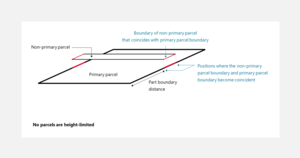
Figure 11: Coincidence with primary parcel boundaries (note neither primary or non-primary parcels are height-limited)
Easement over a unit
In some cases, a non-primary parcel boundary is not permitted to overlap another non-primary parcel boundary.
For example, when creating a new easement over both a Principal Unit and abutting Accessory Unit or Common Property, the easement should be split into two separate non-primary easement parcels. This is because the unit parcels are effectively the underlying parcel for the easement and are the servient tenements.
Unit plans - CSD requirements for easements and covenants on unit plans
While Principal Units and Accessory Units may be currently held in the same record of title, the Accessory Unit can be assigned or transferred to a different Principal Unit. Separate easement areas can then be addressed independently as required.
When depicting existing easements over the base land, the non-primary easement parcel does not need to be split. Existing easements are recorded on the Supplementary Record Sheet and not against the record of title for the units.
It is important that the relationship between the non-primary parcels is clearly depicted.
Non-primary parcel boundary intersections
Where a record of title consists of more than one parcel, a new non-primary parcel may cross an internal primary parcel boundary but not an estate boundary (r 47). There is no requirement to determine the intersection of the non-primary parcel with the internal primary parcel.
Non-primary parcels - Non-primary parcels crossing boundaries
Partial surrender of an existing easement
Where the sole purpose of a CSD is to depict as a non-primary parcel the extent of an existing easement that is to be surrendered, then both the part to remain and the part being surrendered must be defined (r 48). This is illustrated in Figure 12 below.
Non-primary parcels - Surrendering part of an easement or revoking part of a covenant
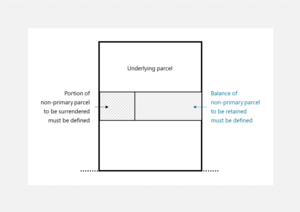
Figure 12: Surrender of part of a non-primary parcel